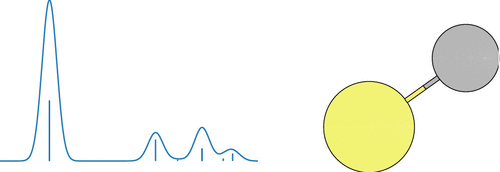当前位置:
X-MOL 学术
›
ACS Earth Space Chem.
›
论文详情
Our official English website, www.x-mol.net, welcomes your
feedback! (Note: you will need to create a separate account there.)
Sulfur Molecules in Space by X-rays: A Computational Study
ACS Earth and Space Chemistry ( IF 2.9 ) Pub Date : 2021-02-24 , DOI: 10.1021/acsearthspacechem.0c00238 Goranka Bilalbegović 1 , Aleksandar Maksimović 2 , Lynne A. Valencic 3, 4 , Susi Lehtola 5
ACS Earth and Space Chemistry ( IF 2.9 ) Pub Date : 2021-02-24 , DOI: 10.1021/acsearthspacechem.0c00238 Goranka Bilalbegović 1 , Aleksandar Maksimović 2 , Lynne A. Valencic 3, 4 , Susi Lehtola 5
Affiliation

|
X-ray astronomy lacks high resolution spectra of interstellar dust analogues and molecules, severely hampering interstellar medium studies based on upcoming X-ray missions. Various theoretical approaches may be used to address this problem, but they must first be shown to reproduce reliable spectra compared to the experiment. In this work, we calculate the sulfur K edge X-ray absorption spectra of H2S, SO2, and OCS, whose spectra are already known from X-ray experiments and predict the X-ray spectrum of CS, which as far as we are aware has not been measured, thereby hampering its detection by X-ray telescopes. We chose these four molecules as the astrochemistry of sulfur is an unsolved problem and as the four molecules are already known to exist in space. We consider three types of methods for modeling the X-ray spectra: more accurate calculations with the algebraic-diagrammatic construction (ADC) and the CC2, CCSD, and CC3 coupled cluster (CC) approaches as well as more affordable ones with transition potential density functional theory (TP-DFT). A comparison of our computational results to previously reported experimental spectra shows that the core–valence separation (CVS) approaches CVS-ADC(2)-x and CVS-CC3 generally yield a good qualitative level of agreement with the experiment, suggesting that they can be used for interpreting measured spectra, while the TP-DFT method is not reliable for these molecules. However, quantitative agreement with the experiment is still outside the reach of the computational methods studied in this work.
中文翻译:

X射线在空间中的硫分子:计算研究。
X射线天文学缺乏星际尘埃类似物和分子的高分辨率光谱,严重阻碍了基于即将进行的X射线任务的星际介质研究。可以使用各种理论方法来解决此问题,但是与实验相比,必须首先显示它们以重现可靠的光谱。在这项工作中,我们计算了H 2 S,SO 2的硫K边缘X射线吸收光谱和OCS,其光谱已从X射线实验中获悉并预测了CS的X射线光谱,据我们所知,CS的X射线光谱尚未被测量到,从而阻碍了X射线望远镜对其的探测。我们选择这四个分子是因为硫的天化学是一个尚未解决的问题,并且已知这四个分子已存在于太空中。我们考虑了三种用于X射线光谱建模的方法:使用代数图解结构(ADC)和CC2,CCSD和CC3耦合簇(CC)方法进行更准确的计算,以及具有过渡电位密度的更实惠的方法功能理论(TP-DFT)。将我们的计算结果与先前报告的实验光谱进行比较,结果表明,核价分离(CVS)方法接近CVS-ADC(2)-x,而CVS-CC3通常与实验产生良好的定性水平,表明它们可以TP-DFT方法对这些分子不可靠,因此可以用来解释测得的光谱。但是,与实验的定量一致性仍然超出了本文研究的计算方法的范围。
更新日期:2021-03-18
中文翻译:

X射线在空间中的硫分子:计算研究。
X射线天文学缺乏星际尘埃类似物和分子的高分辨率光谱,严重阻碍了基于即将进行的X射线任务的星际介质研究。可以使用各种理论方法来解决此问题,但是与实验相比,必须首先显示它们以重现可靠的光谱。在这项工作中,我们计算了H 2 S,SO 2的硫K边缘X射线吸收光谱和OCS,其光谱已从X射线实验中获悉并预测了CS的X射线光谱,据我们所知,CS的X射线光谱尚未被测量到,从而阻碍了X射线望远镜对其的探测。我们选择这四个分子是因为硫的天化学是一个尚未解决的问题,并且已知这四个分子已存在于太空中。我们考虑了三种用于X射线光谱建模的方法:使用代数图解结构(ADC)和CC2,CCSD和CC3耦合簇(CC)方法进行更准确的计算,以及具有过渡电位密度的更实惠的方法功能理论(TP-DFT)。将我们的计算结果与先前报告的实验光谱进行比较,结果表明,核价分离(CVS)方法接近CVS-ADC(2)-x,而CVS-CC3通常与实验产生良好的定性水平,表明它们可以TP-DFT方法对这些分子不可靠,因此可以用来解释测得的光谱。但是,与实验的定量一致性仍然超出了本文研究的计算方法的范围。











































 京公网安备 11010802027423号
京公网安备 11010802027423号